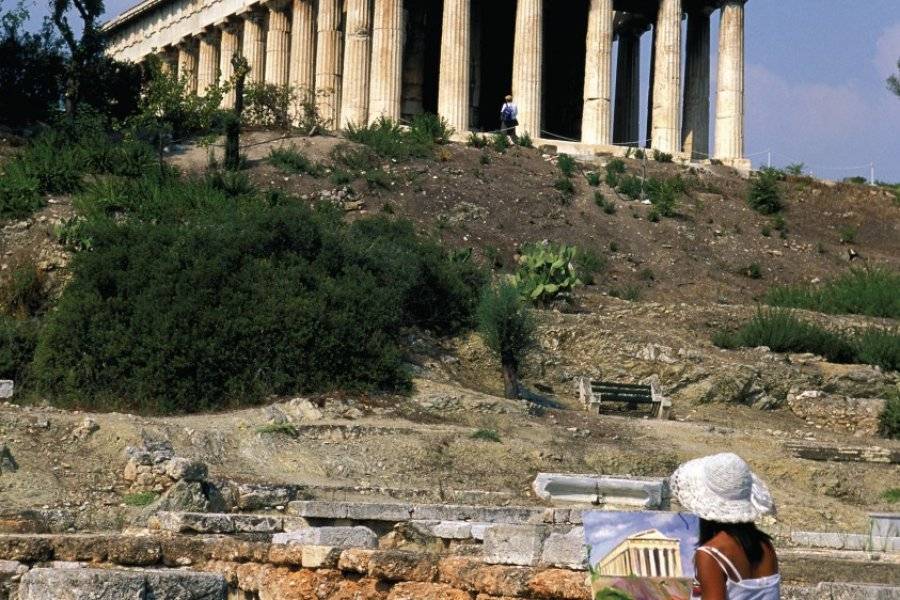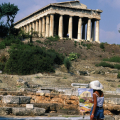Demarcating the limits between Antiquity and the modern period, this site allows to survey the political center of ancient Athens.
History. The Agora is certainly the center of every ancient Greek city: it's where political decisions are made, prisoners are tried and stores are set up. Initially a simple esplanade, the Athens Agora was gradually enriched with colonnaded porticoes where citizens could refresh themselves. It took on its present form in the 6th century BC. Buildings lining the western side of the site were destroyed by the Persians in 480 BC. During the remainder of the5th century, the Athenians rebuilt their Agora, adorning it with additional buildings to the north and south. Shortly after 450 B.C., construction began on the Temple of Hephaestus, better known as the Theion, which you can still see standing above the entire site. The 4th century was marked by construction efforts, but it wasn't until the 2nd century BC that the colonnades (portico or stoa) surrounding the Agora were added, such as the Attalus portico, rebuilt by the American School of Archaeology to house the Agora site museum. In 86 BC, the sack of Athens by Sylla's Romans seriously damaged the buildings south of the Agora. Around 15 B.C., Agrippa had the Odeon built on the axis of the central square, and the temples of the Attica countryside were dismantled and rebuilt on the site of the Agora, in particular the temple of Ares. In the 2nd century AD, other buildings were erected, including the Pantainos Library, the Nymphaeum and the Basilica. In AD 267, Athens was sacked by the Heruli, barbarians from the north. Stones were removed from monuments to build a wall around the Agora, sophists built luxurious dwellings on the northern slopes of the Areopagus, and the Palace of the Giants was built on the ruins of the Odeon. Towards the end of the 6th century AD, the site was abandoned and gradually covered by thick layers of alluvium. Around the year 1000, the Church of the Holy Apostles was built.
Guided tour of the site. We offer a guided tour of the Agora site, starting from the southern entrance, i.e. the one closest to the Acropolis. You'll enter the site by following the route of the ancient Panathenees, where a huge procession started from the Ceramics and ended at the Erechtheion on the Acropolis, crossing the Agora via the Sacred Way. You can see traces of the marble paving that covered the road, as well as the deep marks probably left by the passing chariots. On your right, before entering the site proper, you'll see a series of stores sheltered by a colonnade. On the other side of the road is the southeast temple, whose divinity is unknown. We do know, however, that these columns were salvaged from the temple of Athena at Sounion. After passing through the site gate, you'll see on your left, near the small Church of the Holy Apostles, the foundations of the south-eastern public fountain, dating from the 6th century BC.
We suggest you turn left to follow the remains of the southern portico of the Agora. This vast colonnaded complex comprised a first, intermediate portico which, together with a second portico to the south, framed a vast rectangular square. To the west of the square was a square building that served as a court, although inscriptions found on the site tell us that sessions were held outside under the colonnades. Adjacent to the court, known as the Heliæum, is a square, paved pit, the remains of a water clock or clepsydra, probably dating from the 4th century BC.
Continuing westwards, past the fountain, you'll come across a building that may have been Socrates' prison, as well as busts of prisoners, one of which may represent Socrates himself.
We now suggest you head northwards, past the foot of the rocky promontory on which stands the Temple of Hephaistos. You'll pass the western buildings of the Agora, the oldest on the site. You first pass the circular base of the Tholos. Built around 460 BC, it served as headquarters and canteen for the prytanes, the presiding committee of the Council of 500 members, or boulê. It also housed a set of standard weights and measures. Council meetings were held in the bouleutêrion, the foundations of which can be seen behind the Tholos building. The Council's archives were kept on papyrus, parchment or marble, in another building built next to the Tholos: the metrôon. You'll recognize it by the Ionic portico at the front, which dates back to the 2nd century BC. In front of the metrôon, on the other side of the tour path, stands a large rectangular platform surrounded by a restored balustrade. This is the monument to the eponymous heroes. In the middle of the balustrade are bronze statues of the ten legendary heroes who gave their names to the ten tribes or political districts of Athens. Behind them, you can see the base of a huge altar that must have been dedicated to Zeus.
Continuing northwards, you pass what remains of a small Ionic temple dedicated to Apollo Patrôos, built in 340-330 BC, then a more imposing building with two wings: this is the portico of Zeus Eleutherios, god of Liberty. It was here that all those who contributed to the city's freedom were venerated. To the right of this building stands the royal portico, smaller in size than its neighbor. It was probably built around 460 BC, certainly initially to house and display the laws enacted by Solon. It then served as the headquarters of one of Athens' leading magistrates: the Archon King. It was here that Socrates was interrogated and sentenced to death.
We now invite you to take a closer look at the marvellous temple towering above you: the Temple of Hephaistos, better known as the Theaeion. The sculptures on the two pediments have been lost, but fragments of the Doric frieze and the metopes illustrating the works of Heracles and the exploits of Theseus, from whom it takes its nickname, remain. Let's turn now to the buildings in the center of the Agora. Heading east along the railway wall, we come across the corner of what was once the Altar of the Twelve Gods, the rest of the monument being behind the dividing wall. Founded in 522 BC by Pisistratus the Younger, this sanctuary was dedicated to the twelve gods of Olympus and served as a landmark for measuring distances from Athens.
Let's move on to the colossal statues that stand in the middle of the site: they represent tritons (half-man, half-fish) and giants (half-man, half-serpents). These statues were taken from the facade of Agrippa's now-defunct odeon. Passing between the giants, you come to the ruins of the odeon itself. Its architecture was notable for the absence of columns inside, which was undoubtedly the primary cause of its roof collapsing around 170 BC. Today, you can admire the marble-paved stage. The Heruli destroyed the Odeon in 267 AD, and the Athenians used the building's stones to fortify the city. The cement foundations that today cover the square of the former odeon belonged to a large architectural complex known as the Palace of the Giants.
We now invite you to visit the stoa of Attalus, now home to the Agora Museum. This portico owes its name to King Attalus II, king of Pergamon from 159 to 138 BC, a classic gesture of recognition for a prince of Attica sent to Athens in his youth to receive a proper education.
The stoa consists of two floors, each with 21 rooms. These rooms were occupied by stores as well as administrative offices.
Did you know? This review was written by our professional authors.
Members' reviews on OLD AGORA
The ratings and reviews below reflect the subjective opinions of members and not the opinion of The Little Witty.












